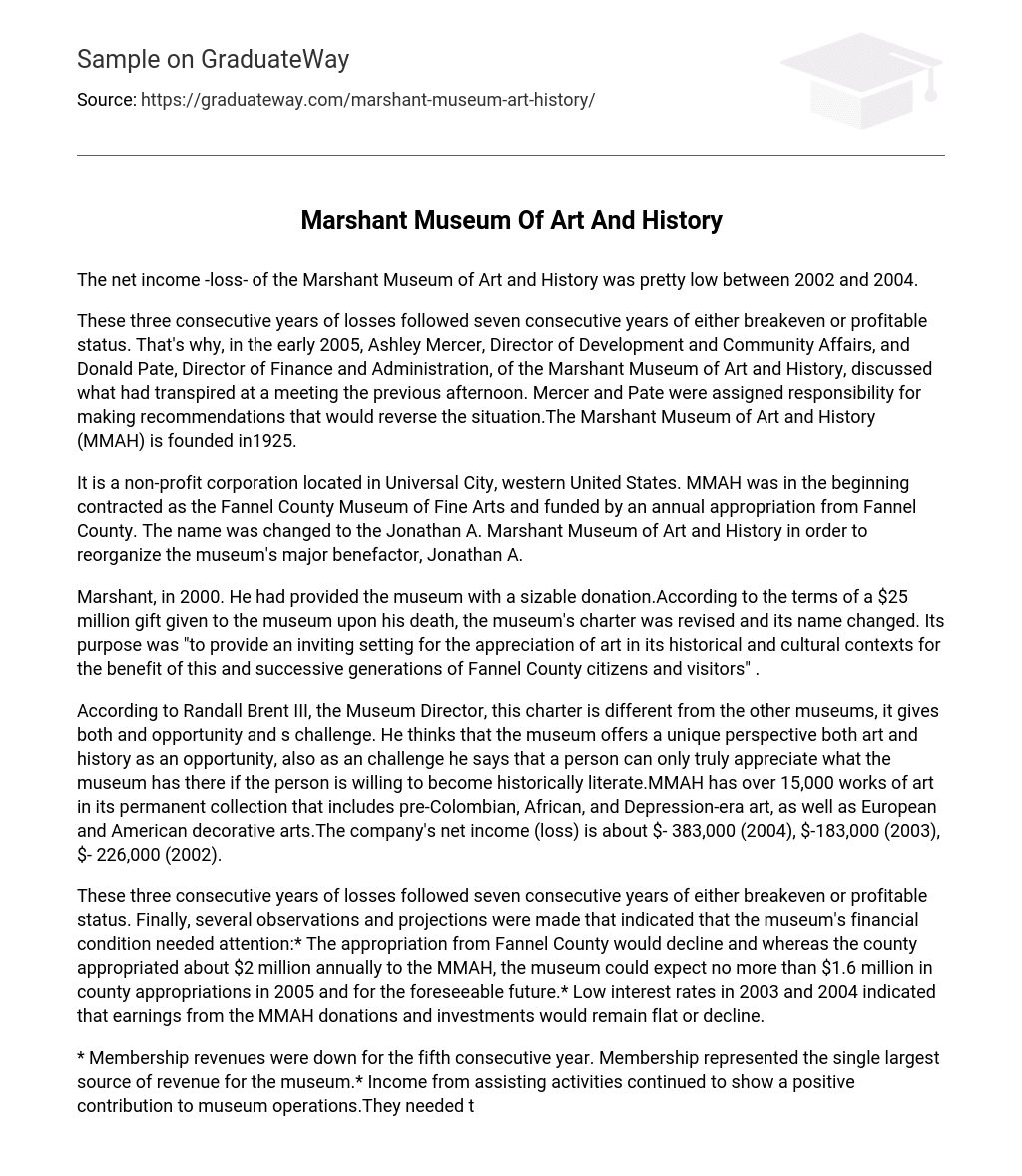From 2002 to 2004, the Marshant Museum of Art and History experienced a relatively small net income loss.
In the early 2005, after seven consecutive years of either breaking even or being profitable, the Marshant Museum of Art and History (MMAH) experienced three consecutive years of losses. Ashley Mercer, Director of Development and Community Affairs, and Donald Pate, Director of Finance and Administration, discussed this at a meeting the previous afternoon. They were given the task of making recommendations to turn things around. The MMAH was founded in 1925.
The MMAH, a non-profit corporation in Universal City, western United States, was originally known as the Fannel County Museum of Fine Arts. It was funded through an annual appropriation from Fannel County. However, to better align with its main benefactor, Jonathan A., the museum’s name was changed to the Jonathan A. Marshant Museum of Art and History.
Marshant made a substantial donation to the museum in 2000, resulting in changes to the museum’s charter and name as stipulated in a $25 million gift received upon his demise. The revised purpose of the museum is to offer a welcoming environment for the appreciation of art within its historical and cultural contexts, benefiting the citizens and visitors of Fannel County for generations to come.
According to Randall Brent III, the Museum Director, the museum’s charter distinguishes it from others by presenting both an opportunity and a challenge. Brent perceives the museum as providing a distinct perspective on art and history, offering an opportunity. However, he also sees it as a challenge because fully appreciating everything the museum offers requires historical literacy. The Museum of Modern Art and History (MMAH) possesses a permanent collection of over 15,000 artworks that encompass pre-Colombian, African, and Depression-era art alongside European and American decorative arts. In terms of financials, the organization had net income (loss) amounts of approximately $-383,000 in 2004, $-183,000 in 2003, and $-226,000 in 2002.
The museum has been incurring losses for the past three years, which marks a notable shift from the preceding seven years of either breaking even or making a profit. It is evident that immediate action must be taken to address the financial situation of the museum. This conclusion is drawn from several observations and projections: The funding provided by Fannel County is diminishing, with an anticipated decrease from an annual allocation of approximately $2 million to $1.6 million in 2005 and beyond. Additionally, the low interest rates witnessed in 2003 and 2004 indicate that revenue generated from donations and investments made to the museum will either remain stable or decline.
Despite a five-year decline in membership revenues, they remain the primary source of income for the museum. However, revenue generated from supporting activities has had a positive impact on the museum’s operations. To tackle this problem effectively, it is vital to focus on improving the museum’s reputation, attracting a larger number of visitors, and increasing its membership base.
Ashley Mercer, the director of Development and Community Affairs, took charge of marketing at the MMAH. Their aim was to improve the museum’s image, increase visits, and boost membership in order to restructure MMAH’s financial situation. The MMAH constantly promotes its special exhibitions and activities through press releases and maintains a strong connection with the local media. Additionally, the museum offers various programs to educate the public, including adult tours, school tours, lectures, and art films.
Furthermore, the museum utilizes local radio stations to broadcast public service announcements promoting special exhibitions. As part of this effort, the museum has also reviewed and updated its membership categories, benefits, and costs. The reorganization includes providing exclusive perks for members such as free limited parking, a monthly calendar, personal tours of exhibition areas, and extraordinary travel opportunities.





